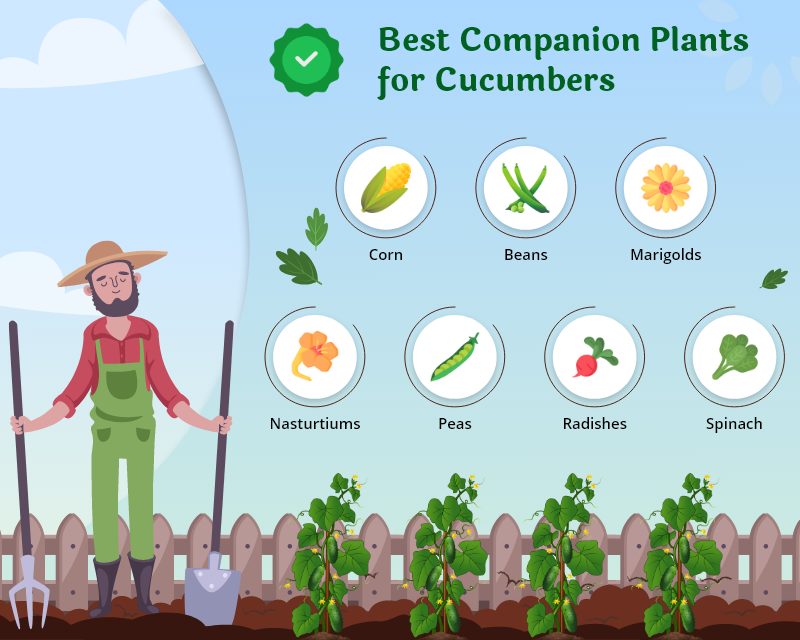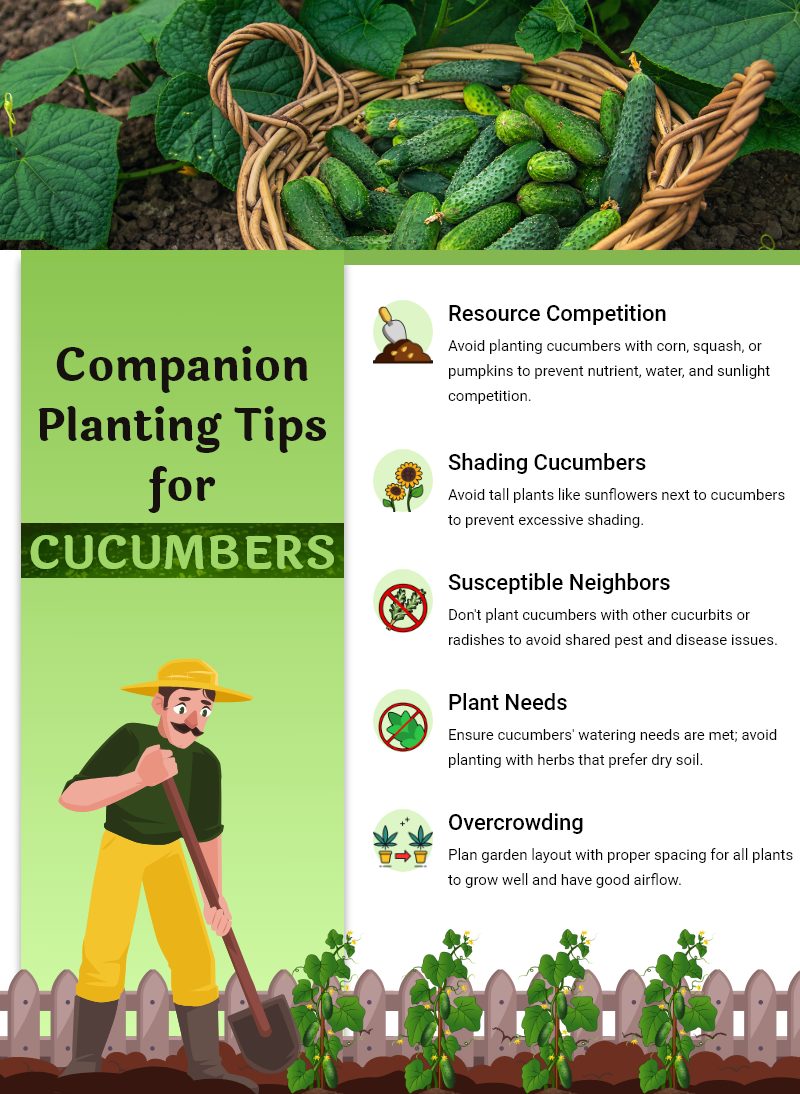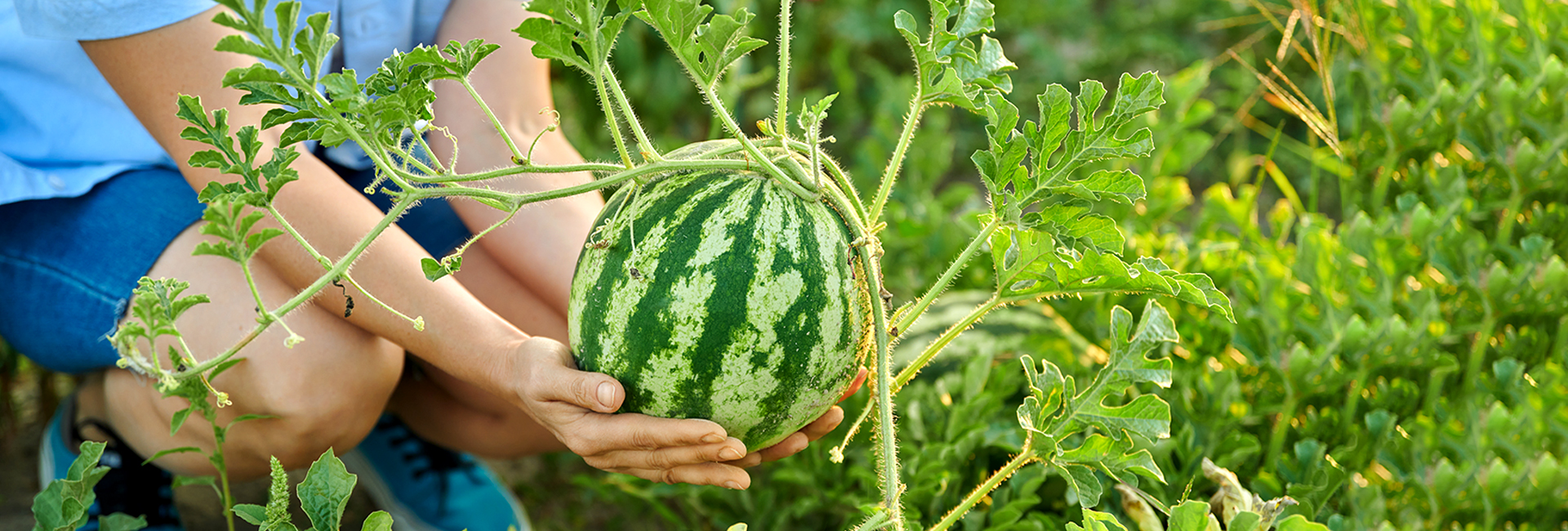Ever feel like your cucumber plants just aren’t reaching their full potential? Disappointed by low yields, wilting leaves, or pesky squash bugs munching on your precious veggies?
Cucumber companion planting might just be your secret weapon for a thriving cucumber haven! The idea of using companion planting is simple. You plant cucumbers near companions that create beneficial growing conditions for cucumbers.
So, what grows best near cucumbers? We’ve compiled the best (and worst) companion plants for cucumbers. Plus, we have tips and tricks to ensure your companion planting success.
What are Cucumber Companion Plants?
Companion planting is a natural strategy that brings together beneficial plants for a harmonious garden ecosystem. With cucumbers, companion plants can deter common pests, increase soil nitrogen, or provide structure for cucumber vines to climb.
For example, the best companion plants for cucumbers attract helpful insects like ladybugs or green lacewings. Both devour cucumber beetles, a common foe. Others deter pests with their strong scents, while nitrogen-fixing companions like beans enrich the soil. This is a natural way to feed your cucumbers nitrogen.
Benefits of Companion Planting for Cucumbers
Cucumber plants are easy to grow. However, they’re very susceptible to pests. Companion planting is one of the best natural ways to determine these common pests.
However, there many other benefits to pairing cucumbers with companion plants, including:
Pest control
Certain cucumber companion plants help deter pests that love munching on cucumbers. Nasturtiums, for example, are a trap crop that attracts cucumber beetles away from your precious cucumbers. They also release a compound that repels these pests.
Improved pollination
Some flowering companions, like dill and borage, attract bees and other pollinators to your garden. This not only helps with cucumber pollination, but also benefits other flowering plants in your garden.
Space optimization
Companion plants can be chosen to utilize the vertical space around your cucumber plants. For instance, climbing peas can grow up a trellis alongside your cucumber vines, maximizing your garden space.
Natural herbicides
Some strong-smelling herbs, like mint and chives, can help deter weeds from growing around your cucumber plants.
Best Companion Plants for Cucumbers

Here are the 10 best plants to grow near cucumbers:
1. Corn
Corn stalks provide much-needed shade for cucumbers in hot weather and can act as a climbing structure. In fact, a version of the Three Sisters involves planting cucumbers, corn and beans together.
2. Beans
Legumes like bush beans fix nitrogen in the soil, benefiting cucumbers and other nearby plants. Beans are a great natural companion for a variety of plants, including cucumbers. If you’ve missed the spring planting window, however, you can plant snap peas in late fall (which is a favorite cool-weather legume).
3. Marigolds
These cheerful flowers deter harmful nematodes and add a splash of color to your garden. Another added benefit: Research shows that marigolds (along with our next companion plant) can reduce damage caused by cucumber beetles.
4. Nasturtiums
These vibrant flowers attract aphids away from your cucumbers, acting as a trap crop. However, they’re also a powerful repellent for squash bugs, which can destroy plants in the cucurbit family (which includes cucumber, squash and melons).
5. Peas
Like beans, peas fix nitrogen in the soil, and their tendrils intertwine with cucumber vines for mutual support. One tip: Peas generally go in the ground in early spring, while cucumbers like warmer summer conditions. Therefore, plan ahead; plant peas in spring and leave a space open next door for cucumbers. Then, once temperatures are warmer, your cucumbers will thrive.
6. Radishes
Their feathery foliage creates a shady haven for beneficial insects, while their deep roots help loosen compacted soil. Some suggest radishes can help to deter cucumber beetles. Plus, you can pair these companions together for a delicious salad.
7. Spinach
Cucumbers might benefit spinach more, by providing shade and protecting spinach from the sun. Note: This benefit only comes if the cucumbers are trellised upward, and they’re placed on the western side of the spinach.
As a companion plant, though, spinach won’t compete with cucumber for resources, so they tend to grow great alongside each other.
8. Dill
As a companion plant, dill can attract some beneficial insects, it also attracts beneficial worms that can help aerate the soil. But the most helpful benefit… Fresh dill is absolutely necessary for adding flavor when it comes time to pickle your cucumbers.
Bad Companion Plants for Cucumbers

Companion planting is all about choosing beneficial pairs. The worst companion plants for cucumbers, therefore, tend to have different watering needs, growing habits, attract harmful pests, or are susceptible to similar diseases.
Avoid these companion plants near your cucumbers:
- Potatoes: Both cucumbers and potatoes are susceptible to similar diseases, so planting them together increases the risk of infection.
- Fennel: This fast-growing plant can crowd out your cucumbers and compete for resources.
- Mint: Mint’s aggressive growth habit can easily overtake and smother cucumbers.
- Sage: Sage can release chemicals that inhibit the growth of some plants, including cucumbers.
- Melons: While members of the same family, cucumbers and melons can compete for nutrients and resources.
- Pumpkins: Like melons, pumpkins are heavy feeders that can compete with cucumbers for space and nutrients.
- Hops: Hops are vigorous climbers that can strangle cucumber vines and limit their growth.
- Walnuts: Black walnut trees release juglone, a toxin that can harm cucumbers and other plants.
Common Mistakes to Avoid When Interplanting with Cucumbers

Companion planting can boost your cucumber harvest, but avoid these pitfalls to ensure your veggie patch thrives:
Competition for resources
Cucumbers are heavy feeders, so avoid planting them next to other vigorous plants like corn, squash, or pumpkins. These will compete for nutrients, water, and sunlight, hindering the growth of both.
Shading cucumbers
While some shade can be beneficial in hot climates, avoid planting tall companions directly next to cucumbers. Sunflowers, for instance, can cast too much shade, stunting cucumber growth.
Planting susceptible neighbors
Don’t plant cucumbers next to other cucurbits (like zucchini) or radishes. These plants share similar vulnerabilities to pests and diseases, so an infestation in one can easily spread to the other.
Ignoring plant needs
Companion planting shouldn’t ignore individual plant requirements. For example, cucumbers prefer consistently moist soil. Planting them next to herbs that thrive in drier conditions can disrupt their watering needs.
Overcrowding
Even with compatible companions, overcrowding is a recipe for trouble. Plan your garden layout with proper spacing in mind to ensure all plants have room to grow and receive adequate airflow.
Conclusion
Companion planting is a win-win for you and your cucumber patch. By creating a supportive plant community, you can enjoy a bountiful harvest, healthier cucumbers, and a vibrant garden ecosystem!
But remember: Too many companion plants or the wrong ones will do more harm than good. Overcrowding, disease and pest pressure, for example, are all common downsides. Hopefully this helps! Happy gardening.
Need organic gardening supplies? Visit a Homegrown Outlet location near you in Upstate New York.




